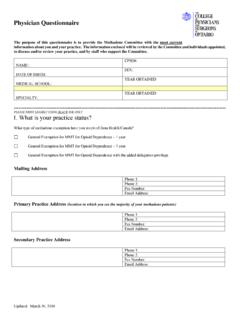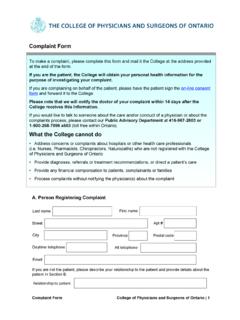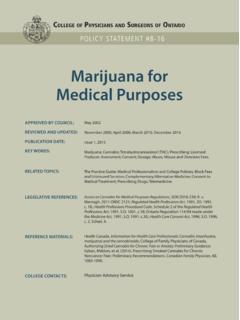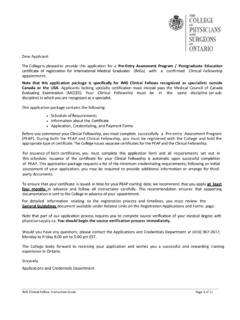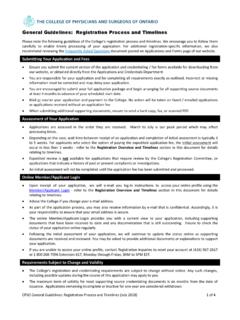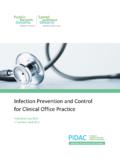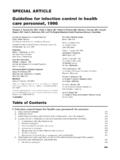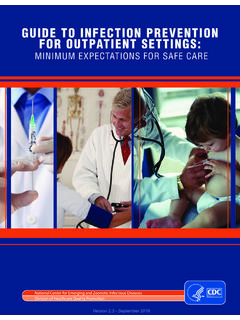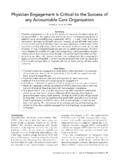Transcription of in the Physician’s Office - cpso.on.ca
1 Infection ControlPhysician s Officein the2004 EditionPrefaceThe need for strict infection prevention and control measures in medicalfacilities has probably never been more apparent to the general publicand to the medical community at large than it is now. Our recent experiencewith Severe Acute Respiratory Syndrome (SARS), as well as events related toinadequate sterilization and disinfection of medical equipment, have under-scored the notion that every person is vulnerable if proper safeguards are notin place to prevent the transmission and acquisition of infection.
2 According to the Public Hospitals Act, medical institutions must have anInfection control Committee, and a proper infection control infrastructure isrequired to meet hospital accreditation standards. In contrast, the intent ofthese requirements has not consistently been realized in Office practices. Theface of infection control is rapidly changing with new infections beingdescribed, more outpatient procedures being performed, new products andmedical equipment being manufactured, and new standards, directives andguidelines being developed by provincial, national and international organiza-tions.
3 This third edition of the guidelines is as comprehensive as possible, includingnew and updated information, as well as issues physicians should considerwhen setting up a new Office . We have created algorithms to simplify com-prehension and implementation of the guidelines and other visuals that canbe posted in the Office as required. Our goal is to educate the medicalcommunity on current infection control practices necessary for an officepractice. By doing this we will elevate the standard of practice in health careand protect the public by minimizing the risk of infection transmission.
4 We hope that this guideline will be a useful tool, a handy reference toprovide you with a framework and practical information to prevent the trans-mission of infection to patients, visitors, health care workers and otheremployees associated with your clinical Matlow, MD, MSc, FRCPCEXECUTIVESUMMARYINFECTIONCONTROLINT HEPHYSICIAN SOFFICE1 This edition of Infection control in the physician s Officeis dedicated to thememory of our two nursing colleagues, Nelia Laroza and Tecla Lin, and Dr. Nestor Yanga, all of whom contracted SARS while caring for patientsand lost their lives in so 1993, the College of Physicians and Surgeons of Ontario asked that ateam of outside experts be assembled to draw up infection control guide-lines specifically designed to meet the needs of physicians in their College felt that there was an information gap in this area and acceptedresponsibility for drafting a set of practical infection control guidelines.
5 The first edition was published in College is grateful for the work of the original team which researched,wrote and assembled the 1995 guidelines: Anne Matlow, MD, MSc, FRCPC;Henry Wu, MD, BSc; Carol Goldman, RN, BScN, CIC; and Arthur Franklin,BSc, PhD; as well as the work on the 1999 and 2004 editions by Dr. Matlowand Ms. Matlow has been at Toronto s Hospital for Sick Children since 1989,where she is the Director of Infection Prevention and control and PhysicianLiaison, Patient Safety. She is currently Chair of the Standards and GuidelinesCommittee of the Community and Hospital Infection control Association(CHICA-Canada).
6 Dr. Matlow is also an Associate Professor in theDepartments of Paediatrics, Medicine, Laboratory Medicine and Pathobiologyat the University of Goldman is an Infection control Practitioner at the Hospital for SickChildren in Toronto. Her interest in infection control began in 1978, and shehas been an active member of the Community and Hospital Infection ControlAssociation-Canada (CHICA), serving on the board and in its various commit-tees over the years. She sits on many local and provincial committees.
7 Ms. Goldman is active in preparing infection control guidelines at both theprovincial and federal control in the physician s Office , 2004 edition, is being sent to allphysicians in Ontario as an insert in the March/April 2005 issue of Members Dialogue, the official publication of the guidelines are also available on the College s website ,in the Publications section. Special thanks to the current Committee: Anne Matlow, MD, MSc,FRCPC (Chair); Geoffrey Bond, MD, BSc(Hon), LLB; Carol Goldman, RN, BScN,CIC; Bart Harvey, MD, PhD, MEd,FACPM, FRCPC;Robin Williams, MD, FRCPC; Anne-Luise Winter RN,BScN, MHSc, CIC; Henry Wu, MD, BSc; Dick Zoutman, MD, FRCPC;and Ms.
8 Betty Moseley-Williams,Public Member, CPSO. 2 INFECTIONCONTROLINTHEPHYSICIAN SOFFICET able of Contents Executive Summary ..5 Introduction ..7 PATIENT CARE ..9 Transmission of Organisms ..9 Routine Practices ..10 Hand Hygiene ..10 Personal Protective Equipment ..14 Handling and Disposal of Sharps ..16 Patient Appointments: Booking, Reception and Triage ..16 Transmission-Based Precautions ..18 Airborne Transmission Precautions ..18 Droplet Transmission Precautions.
9 19 Contact Transmission Precautions ..20 Prevention of the Development of Antibiotic Resistant Organisms ..22 HEALTH CARE WORKERS ..23 Immunization of Personnel ..23 Tuberculin Skin Test (TST) ..24 Personnel Health ..25 THE ENVIRONMENT ..30 General Housekeeping of the Office ..30 Materials and Practices ..30 Spot Cleaning of Body Fluid Spills ..31 Equipment and Material Maintenance Practices ..31 Waste Disposal ..33 Medical Instruments ..34 General Principles ..34 Single-Use Medical Devices.
10 34 INFECTIONCONTROLINTHEPHYSICIAN SOFFICE3 Cleaning, Disinfection and Sterilization of Medical Instruments ..34 Cleaning of Instruments ..35 Sterilization and Disinfection: General ..36 Sterilization ..36 Disinfection ..41 WHMIS ..44 Office Design/Renovations ..44 Conclusion ..45 APPENDICES ..46 Appendix 1 ..46 Appendix 2 ..47 Appendix 3 ..48 Appendix 4 ..49 Appendix 5 ..53 Appendix 6 ..53 Appendix 7 ..54 Appendix 8 ..55 Appendix 9 ..56 Appendix 10 ..57 Appendix 11 ..58 Appendix 12.
